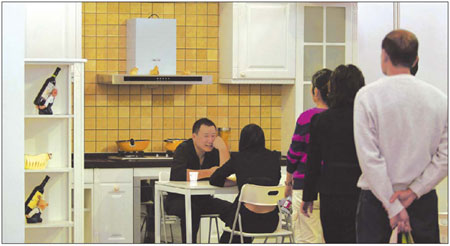Top News
Developing a fine taste for the high life
Updated: 2011-01-24 10:18
By Karen Yip (China Daily)
|
 |
|
Customers line up to consult an interior designer for home decorating ideas at a property fair in Nanjing, capital of East China's Jiangsu province. Because the central government's tough housing policies have kept the growth of property sales at bay in big cities, fierce competition and consequent downward pressure on profits in the interior designing industry are affecting small firms. However, second- and third-tier cities are expected to benefit from the spillover effect from the maturing of the property sector in first-tier cities. [Photo/China Daily] |
Architects, designers bring style and chic to the booming property market
BEIJING - It was a dream commission, one that Massimo Bagnasco, partner and managing director of architectural design firm Progetto CMR (Beijing), did not expect: Devise a high-end office tower that integrates energy-saving elements with tasteful furnishings and finely-honed durable material.
"There was an instant understanding between us. He is, by far, my best client, who listens to the architect and designer," said Bagnasco. "When we first met, he told me his style is Armani - luxury in simplicity."
| ||||
Bagnasco's 30-person business is among the scores of midsize to large foreign and Chinese architectural design firms across China that have prospered from the property boom.
Inevitably, the soaring market ushered in a change in Chinese consumer demand involving style, quality, size and greener housing developments, said Zou Huying, a professor at Tsinghua University's School of Architecture. She also represents about 10,000 Chinese interior designers as the chairperson of the China Institute of Interior Design (CIID).
"The interior design sector in China has come of age. We're beginning to consider the environment, build, materials, water, soil, power, et cetera when drafting the blueprint," she said.
For 2011, she doesn't expect a high inflation rate or skyrocketing property prices to affect the businesses of midsize to large architectural design firms. However, fierce competition and pressure on profits are expected to affect small firms, especially those in Shanghai, she said.
Second- and third-tier cities are expected to benefit from the spillover effect from the maturing of the property sector in the first-tier cities.
"As a matter of fact, it's happening right now and we're getting more businesses in these cities," said Hank M. Chao, founder of Taiwan-based MoHen Design International, which has offices in Shanghai, Chongqing and Tokyo.
The firm's timeless, well-balanced designs in keeping with the environment can be seen from its villa projects in Shanghai to a business entity in Kunshan.
Primary finishing materials such as Chinese granite, stainless steel and oak veneer are no longer uncommon in residential projects in China.
The acceptance of design concepts that used to be considered foreign has seen some Chinese homes using, for instance, a rustic, elegant bamboo curtain or crystal beads to separate the private space from the public, or the use of semi-transparent glass to create an illusion of space and light.
"The local Chinese clients are looking for a more luxurious style and I think it's understandable," said Chao.
Hong Kong Interior Design Association (HKIDA) Chairman Kinney Chan said the upswing in the property sector has transformed China from creating what were historically known as "bare shell" projects - apartments or houses with electrical outlets but with buyers responsible for installing fixtures, floors, and doors - into "standard provision" or "complete package" projects.
According to Zou, between 30 and 40 percent of Beijing's residential projects are furbished apartments. She expects this to be a trend among property developers such as listed developer China Vanke Co Ltd that has its own interior designing unit to assist its property business.
There are two clear trends underpinning China's property market. One is the improve ment of the size and quality of housing, said Stephen Joske, director, Access China, at the Economist Intelligence Unit (EIU).
"At present, the average urban residential floor space for a person in China is less than 30 square meters. Despite the small size of families, demand for bigger houses will rise as people get richer," said Joske. "At the same time changing tastes will lead to more demand for everything, from better quality fittings to cleaner and greener housing developments."
Even though there are numerous architects and designers from the world anticipating the development of China's architecture, local architects are still trying to discover their own style direction, forms and identity, CIID's Zou said.
"Despite a booming economy, China has yet to produce its very own Frank Gehry," she said, referring to the award-winning Canadian-American architect based in Los Angeles.
However, some have pointed to I.M. Pei's work, an architect born in China and known as a post-modernist in China's architectural history. His work for the Suzhou Museum might represent the major spirit of the modernization of China.
Pei has successfully mixed traditional Chinese architecture with contemporary design concepts of space, flow of air, natural light and modern geometries into his own distinctive style.
Another trend that will influence the property sector and industries indirectly related to the sector is China's sustained growth for the next two decades as urbanization continues.
"China is still a predominantly rural country," said Joske. "Even though many people in rural areas have jobs in towns and cities, there is still much development ahead as incomes rise and people move to better housing and better jobs in urban areas."
The EIU's new population forecasts for China show that even though China's total population will peak only 14 years from now, the urban population won't stop growing until 2039.
In a Dec 17 report, the China Land Surveying and Planning Institute, under China's Ministry of Land and Resources, said that average land prices reached 2,882 yuan ($437.13) per square meter in the final quarter of 2010 in some key cities it monitored, up 2.53 percent compared with the previous quarter.
On a year-on-year basis, the figure represented an increase of 8.62 percent, the report showed.
Rising land prices also pushed up property prices. The National Bureau of Statistics announced on Jan 17 that December 2010 home prices in 70 major Chinese cities rose 0.3 percent month-on-month and 6.4 percent year-on-year.
The report also showed average urban land prices in the Yangtze River Delta Region were the highest, at 4,403 yuan a square meter, followed by those in the Pearl River Delta Region, at 3,830 yuan a square meter.
To rein in runaway property prices, the government in April raised downpayments, ended mortgage discounts, tightened rules on loans to developers and made it harder to buy more homes.
Specials

President Hu visits the US
President Hu Jintao is on a state visit to the US from Jan 18 to 21.

Ancient life
The discovery of the fossile of a female pterosaur nicknamed as Mrs T and her un-laid egg are shedding new light on ancient mysteries.

Economic Figures
China's GDP growth jumped 10.3 percent year-on-year in 2010, boosted by a faster-than-expected 9.8 percent expansion in the fourth quarter.



